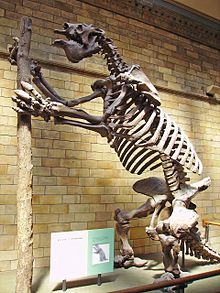Megathere
|
Megatherium Temporal range: Early Pliocene to Early Holocene, 5–0.010 Ma Possible later date of 0.008 Ma |
|
|---|---|
 |
|
| M. americanum skeleton, Natural History Museum, London | |
| Scientific classification | |
| Kingdom: | Animalia |
| Phylum: | Chordata |
| Class: | Mammalia |
| Order: | Pilosa |
| Family: | †Megatheriidae |
| Subtribe: | †Megatheriina |
| Genus: | †Megatherium |
| Type species | |
| †Megatherium americanum Cuvier, 1796 |
|
| Species | |
|
|
| Synonyms | |
|
|
Megatherium (/mɛɡəˈθɪəriəm/ meg-ə-THEER-ee-əm from the Greek mega [μέγας], meaning "great", and [θηρίον], "beast") was a genus of elephant-sized ground sloths endemic to South America, sometimes called the giant ground sloth, that lived from the Early Pliocene through the end of the . Among land mammals, its size was exceeded by only a few other species, including mammoths and the much older Paraceratherium.
The first fossil specimen of Megatherium was discovered in 1788 by Manuel Torres, on the bank of the Luján River in Argentina. The fossil was shipped to Museo Nacional de Ciencias Naturales in Madrid the following year, where it remains. It was reassembled by museum employee Juan Bautista Bru, who also drew the skeleton and some individual bones.
Based on Bru's illustrations, comparative anatomist Georges Cuvier determined the relationships and appearance of Megatherium. He published his first paper on the subject in 1796, a transcript of a previous lecture at the French Academy of Sciences. He published on the subject again in 1804; this paper was republished in his book Recherches sur les ossemens fossiles de quadrupèdes. In his 1796 paper, Cuvier assigned the fossil the scientific name Megatherium americanum. Cuvier determined that Megatherium was a sloth, and at first believed that it used its large claws for climbing trees, like modern sloths, although he later changed his hypothesis to support a subterranean lifestyle, with the claws used to dig tunnels.
...
Wikipedia
